Limousine
A limousine (/ˈlɪməziːn/ or /lɪməˈziːn/), or limo for short,[1] is a large luxury vehicle driven by a chauffeur with a partition between the driver's compartment and the passenger's compartment.[2]
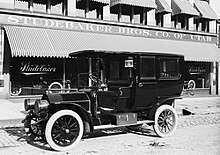
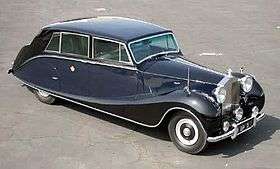
A very long wheelbase luxury sedan (with more than four doors) driven by a professional driver is called a stretch limousine.[3]
In some countries, such as the United States, Germany or Canada, a "limousine service" is a pre-booked hire car with driver, regardless of the type of vehicle. It also describes a large vehicle for transporting passengers to and from an airport.[2]
In German-speaking countries, a Limousine is simply a full-size sedan, while a lengthened-wheelbase car is called Stretch-Limousine.
Etymology
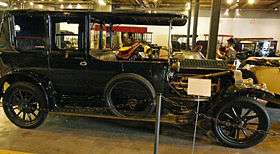
The word limousine is derived from the name of the French region Limousin. However, how the name of the region transferred to the car is uncertain.
One possibility involves a particular type of carriage hood or roof physically resembled the raised hood of the cloak worn by the shepherds there.[4][5]
An alternate etymology speculates that early some chauffeurs wore a Limousin-style cloak in the open driver's compartment, for protection from the weather.[6] The name was then extended to this particular type of car with a permanent top projecting over the chauffeur.[4] This former type of automobile had an enclosed passenger compartment seating three to five persons, with only a roof projecting forward over the open driver's area in the front.[7]
History
Rich owners of expensive carriages and their passengers were accustomed to their own private compartment leaving their coachman or driver outside in all weathers. When automobiles arrived the same people required a similar arrangement for their chauffeurs. As such, the 1916 definition of limousine by the US Society of Automobile Engineers is "a closed car seating three to five inside, with driver's seat outside".[8]
In Great Britain, the limousine de-ville was a version of the limousine town car where the driver's compartment was outside and had no weather protection.[9](p103) The limousine-landaulet variant (also sold in the United States) had a removable or folding roof section over the rear passenger seat.[9](p100)
In the United States, sub-categories of limousines in 1916 were the berline defined as "a limousine having the driver's seat entirely enclosed", and the brougham, defined as "a limousine with no roof over the driver's seat."[8]
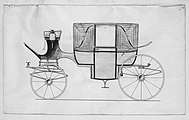 Diagram showing an exposed driver's seat
Diagram showing an exposed driver's seat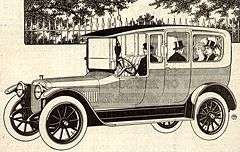 1915 Winton Six Limousine- note the open driver's compartment
1915 Winton Six Limousine- note the open driver's compartment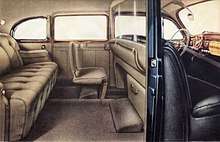 1941 Lincoln Custom limousine interior
1941 Lincoln Custom limousine interior
Characteristics
The limousine body style usually has a partition separating the driver from the rear passenger compartment.[6][9](p96) This partition includes a usually openable glass section so passengers may see the road. Communication with the driver is possible either by opening the window in the partition or by using an intercom system.
Limousines are often long-wheelbase vehicles, in order to provide extra legroom in the passenger compartment. There will usually be occasional or jump seat at the front of the compartment (either forwards-facing, rear-facing or able to face either direction).
Many nations have official state cars designed to transport government officials. The top leaders have dedicated and specially equipped limousines. The United States Presidential State Car is the official car of the President of the United States.
- Official state car of Queen Elizabeth II
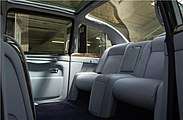 Passenger compartment of Queen Elizabeth's car with jump seats folded down
Passenger compartment of Queen Elizabeth's car with jump seats folded down.jpg) Cadillac One limousine of the President of the United States
Cadillac One limousine of the President of the United States
Stretch limousines

Stretch limousines are longer than regular limousines, usually in order to accommodate more passengers. Stretch limousines may have seating along the sides of the cabin.
A "stretch limousine" was created in Fort Smith, Arkansas, around 1928 by a coach company named Armbruster. Armbruster's cars were primarily used to transport famous "big band" leaders, such as Glenn Miller and Benny Goodman, and their bands and equipment. These early stretch limousines were often called "big band buses". Armbruster called their lengthened cars "extended-wheelbase multi-door auto-coaches". Their 12-passenger people movers were used by hotels, taxis, airlines, corporations and tour companies.[10]
Novelty limousines
A variety of vehicles have been converted into novelty limousines.[11] They are used for weddings, parties and other social occasions.[12] Another style of novelty limousine are those painted in bright colours, such as purple or pink.[13]
Vehicles converted into novelty stretch limousines include the East German Trabant, Volkswagen Beetle, Fiat Panda, and Citroën 2CV. There are even instances of Corvettes, Ferraris, and Mini Coopers being stretched to accommodate up to 10 passengers.
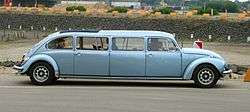 Volkswagen Beetle limousine
Volkswagen Beetle limousine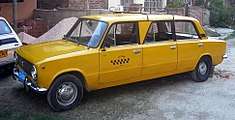
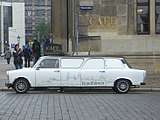 Trabant limousine
Trabant limousine
United States

The last production limousine, by Cadillac, with forward-facing jump seats was in 1987 (with their Fleetwood Series 75 model), the last Packard in 1954, and the last Lincoln in 1939, though Lincoln has offered limousines through their dealers as special order vehicles at times. Several Lincoln Premier cars were also built, one being owned by Elvis Presley. Vehicles of this type in private use may contain expensive audio players, televisions, video players, and bars, often with refrigerators. The President of the United States has ridden in a variety of brands of limousine stretching back to 1899.[14]
In the United States, the most popular vehicles for stretch limousines conversion are the Lincoln Town Car, Cadillac XTS, Cadillac Escalade, Chrysler 300, Hummer H2, Ford Excursion, and the Lincoln Navigator.
United Kingdom

.jpg)
Due to the partition behind the driver, the London black cabs are a type of limousine. The jump seats, also referred to as taxi-tip-seats, usually carry advertising on the underside; the advertisements are visible to the passengers when the tip-seats are not in use.
Current limousine production
Examples of limousines currently produced by vehicle manufacturers include:
"Limousine service" hire cars
In the United States, Canada, and Australia, "limousine service" (also known as "car service") is the process of pre-booked hire of any car with a driver. The car is usually a luxury car, but not necessarily a limousine.
See also
| Look up limousine in Wiktionary, the free dictionary. |
| Wikimedia Commons has media related to Limousines. |
References
- Garner, Bryan. Garner's Modern American Usage. Oxford University Press. ISBN 9780199874620. Retrieved August 2, 2020.
- "Definition of limousine". merriam-webster.com. October 28, 2019. Retrieved November 6, 2019.
- "Definition of Stretch Limo". merriam-webster.com. Retrieved November 6, 2019.
- Dyke, Andrew Lee (1920). Dyke's Automobile and Gasoline Engine Encyclopedia (Twelfth ed.). p. 582. Retrieved June 27, 2015.
- Ayto, John (2009). Word Origins. A&C Black Publishers. ISBN 978-1-4081-0160-5. Retrieved June 27, 2015.
- The Random House College Dictionary. Random House. p. 777. ISBN 0-394-43600-8.
1. an automobile having a permanently enclosed compartment for from three to five persons, the roof of which projects forward over the driver's seat in front...[< F, special use of limousine long cloak, so called because worn by the shepherds of Limousin, a former province in central France]
- "Definition of limousine" (Complete & Unabridged Digital ed.). Collins English Dictionary. 2012. Retrieved November 6, 2019.
- "What's What in Automobile Bodies Officially Determined". The New York Times. August 20, 1916. Retrieved June 27, 2015.
Here it is, with other body types and distinctions, officially determined recently by the Nomenclature Division of the Society of Automobile Engineers
- Haajanen, Lennart W. (2003). Illustrated Dictionary of Automobile Body Styles. Jefferson, NC: McFarland. ISBN 0-7864-1276-3. Retrieved January 1, 2019.
- Coachbuilt.com accessed July 19, 2018
- "Dave's Classic Limousines Pictures: Novelty Limousines". Retrieved June 27, 2015.
- Pedersen, Stephanie (2004). KISS guide to planning a wedding. DK Publishers. pp. 195–196. ISBN 978-0-7894-9695-9.
- Naylor, Sharon (2004). 1000 Best Wedding Bargains. Sourcebooks. p. 198. ISBN 978-1-4022-0298-8. Retrieved June 27, 2015.
novelty limousines.
- Huffman, John Pearley (January 19, 2009). "The Secret Seven: The Top Presidential Limousines of All Time". Popular Mechanics. Retrieved June 27, 2015.